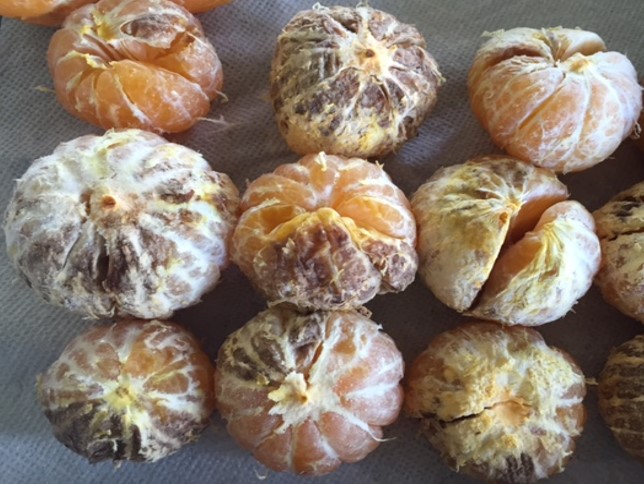
Mary Eloise Babin Cade
December 5, 2022
Geraldine “Gerry” Duval Fanguy
December 5, 2022By Raj Singh, LSU AgCenter Plant Doctor
Citrus is the most popular kind of fruit grown in Louisiana. This time of year, satsumas and other types of citrus are abundant — and delicious. Several biotic and abiotic stresses affect citrus yields, however, and may dishearten home gardeners when they cannot enjoy their harvest.
One issue that the citrus growers face is internal dry rot of fruit. Mature fruit affected by this condition may look healthy on the outside — but peeling the fruit reveals dry, discolored flesh. This internal dry rot is caused by a yeast called Nematospora coryli transmitted by the western leaffooted bug (Leptoglossus zonatus).
The leaffooted bug is widespread and a pest of many crops including fruits, vegetables, grains, nuts and ornamentals. It is a major pest of citrus and primarily attacks satsuma mandarins. It feeds by inserting its piercing-sucking mouthparts in the fruit. Feeding on ripening fruit causes premature color break and fruit drop. Injury usually occurs as the fruit matures in the fall. While feeding, the leaffooted bug transmits the yeast responsible for internal dry rot.
Adults can fly considerable distances and move from other crops to satsumas in fall during fruit ripening. Leaffooted bugs will congregate in large colonies on individual trees while neighboring trees are completely free of bugs.
Adult bugs are dark brown in color, and their hind legs are flattened and appear leaflike. Nymphs, or immature bugs, look totally different from adult bugs. Their body color ranges from orange to reddishbrown with black legs.
Leaffooted bugs are primarily managed by using insecticides, but biological control using other insects and entomopathogenic fungi is also available. Homeowners may spray horticulture oils or Malathion 57EC for managing leaffooted bugs in backyard trees. Just remember — do not spray Malathion on plants in full bloom and make sure to wait at least seven days after spraying to harvest fruit.
Another issue citrus growers may encounter is puffy fruit. Puffy, misshapen fruit is mostly a problem on young, vigorously growing satsuma trees. As the tree becomes older, the occurrence of puffy fruit decreases. Puffy fruit on older trees results from fruit that sets on late blooms during periods of warm weather.
Puffy satsumas have thick, wrinkled rinds and appear pear-shaped as compared to round, smooth, healthy fruits. When peeled, the satsumas look dry and do not have any juice.
Little can be done to prevent puffy fruit. But good growing conditions, proper fertility and pest control are always helpful in maintaining the health of your citrus trees.
For more information on citrus problems, contact the LSU AgCenter Plant Diagnostic Center at 225-578-4562 or visit www.lsuagcenter.com/plantdiagnsotics.









